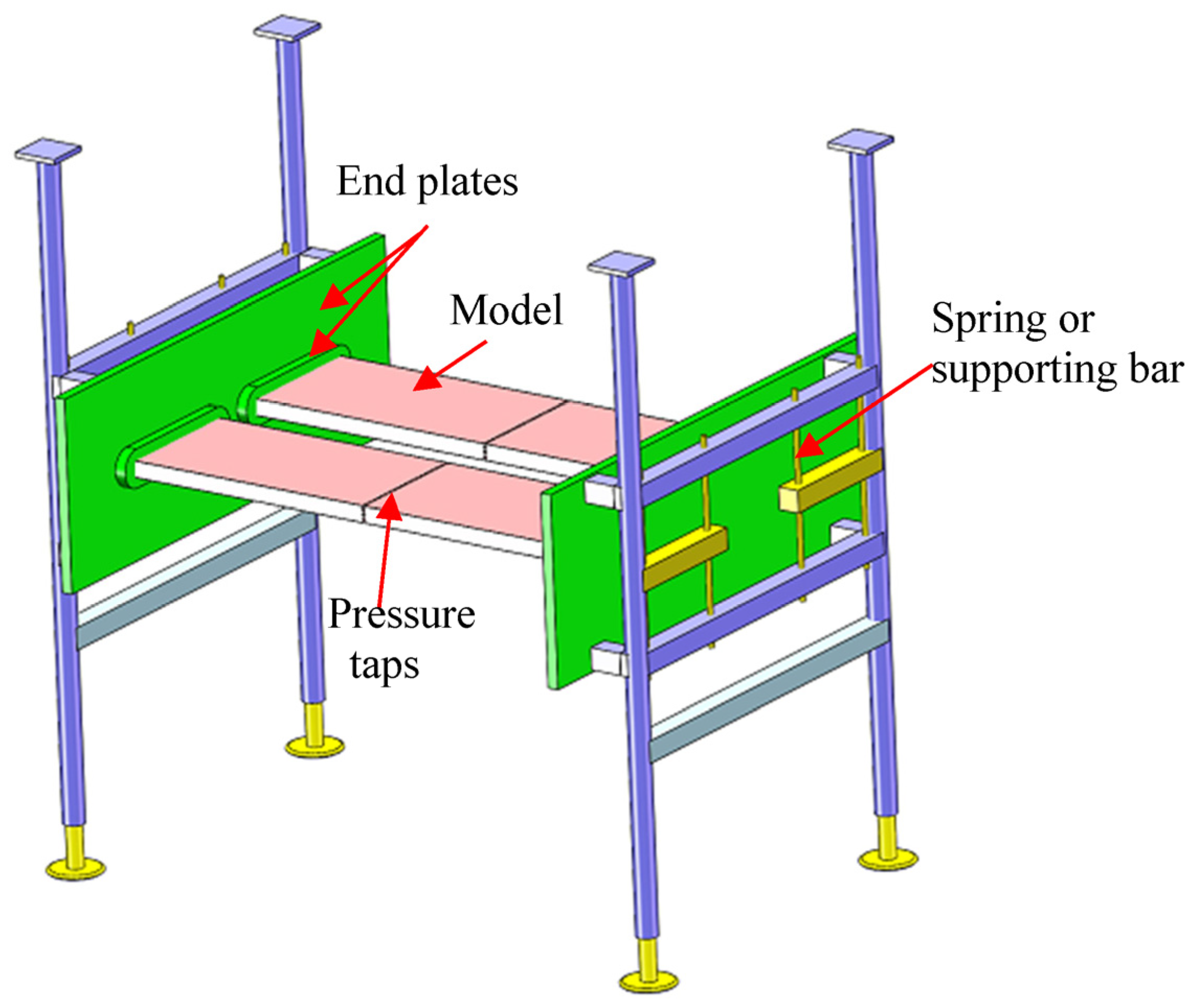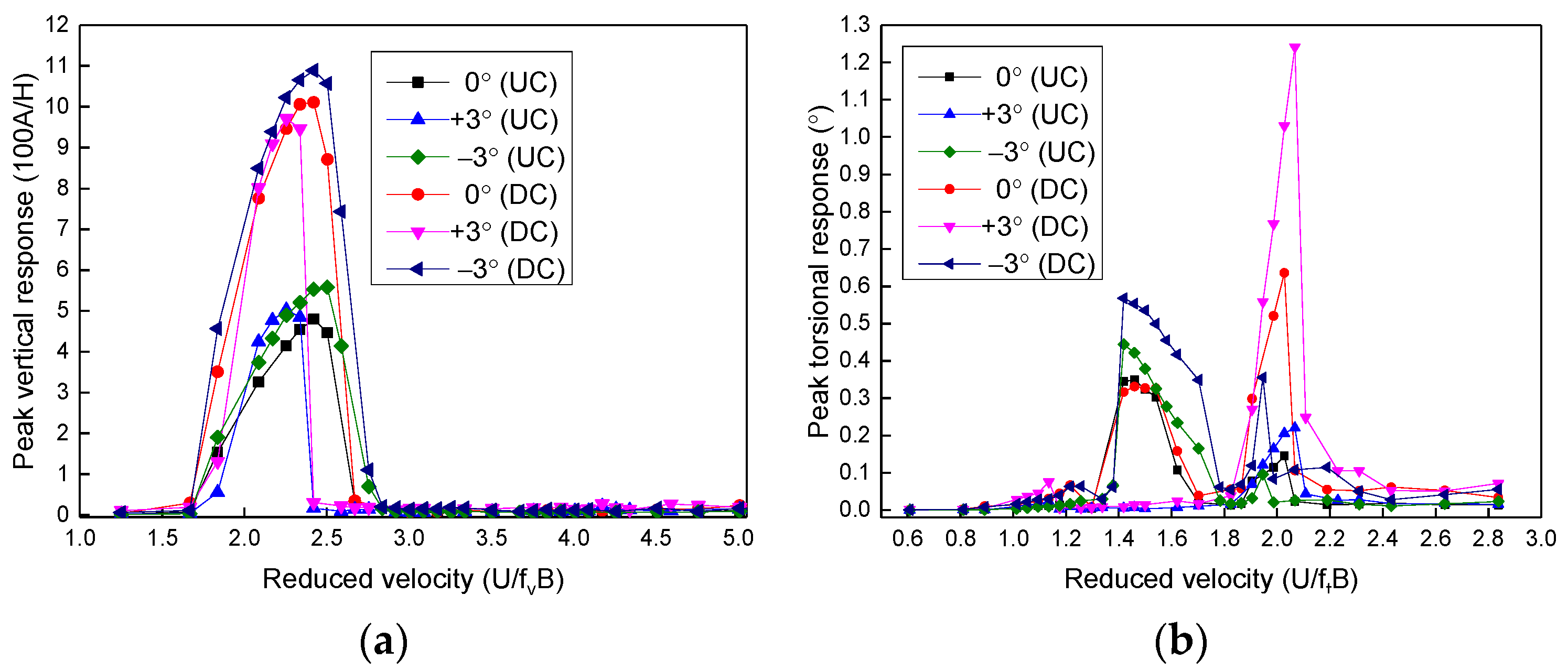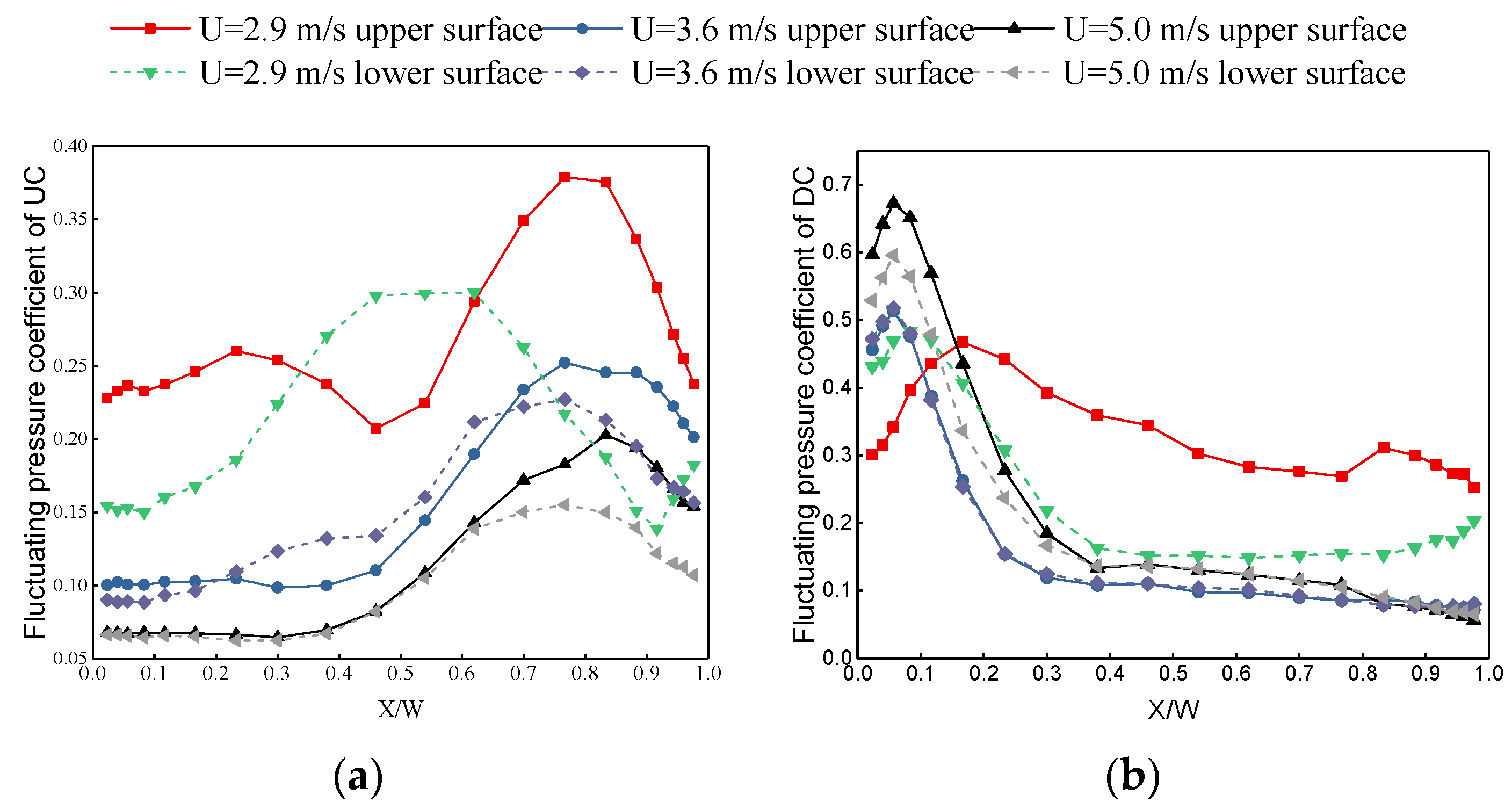Study on VIV Behavior of Two 5:1 Rectangular Cylinders in Tandem Based on Correlation Analysis
Abstract
:1. Introduction
2. Wind Tunnel Tests
3. Results of Wind Tunnel Tests
3.1. VIV Responses under Different Angles of Incidence
3.2. Results of Pressure Measurement
4. Correlation Analysis
5. Conclusions
- (1)
- The results of dynamic tests indicate that the VIV performance of two 5:1 rectangular cylinders in tandem is different at three incidence angles. Generally, the vertical VIV response is unfavorable at the −3° angle of incidence. However, the torsional VIVs of the upstream body are more significant at 0° and −3°, while the general trend for the torsional VIV behavior of the downstream cylinder can hardly be obtained.
- (2)
- The pressure measurements show that the mean and fluctuating pressure distributions of the cylinders under vertical VIVs are different from the results under torsional VIVs. Pressure measurements should be conducted under corresponding wind velocities to analyze the pressure field of twin rectangular cylinders when they undergo VIVs.
- (3)
- The correlation analysis using time-frequency domain statistical parameters indicates that the contribution of distributed vortex-excited forces is significant in the region of the trailing surface of the upstream cylinder and the leading surface of the downstream cylinder.
Author Contributions
Funding
Data Availability Statement
Conflicts of Interest
References
- Taylor, I.; Vezza, M. Prediction of unsteady flow around square and rectangular section cylinders using a discrete vortex method. J. Wind. Eng. Ind. Aerodyn. 1999, 82, 247–269. [Google Scholar] [CrossRef]
- Murakami, S.; Mochida, A. On turbulent vortex shedding flow past 2D square cylinder predicted by CFD. J. Wind. Eng. Ind. Aerodyn. 1995, 54–55, 191–211. [Google Scholar] [CrossRef]
- Matsumoto, M.; Shirato, H.; Araki, K.; Haramura, T.; Hashimoto, T. Spanwise coherence characteristics of surface pressure field on 2-D bluff bodies. J. Wind. Eng. Ind. Aerodyn. 2003, 91, 155–163. [Google Scholar] [CrossRef]
- Shimada, K.; Ishihara, T. Application of a modified k–ε model to the prediction of aerodynamic characteristics of rectangular cross-section cylinders. J. Fluids Struct. 2002, 16, 465–485. [Google Scholar] [CrossRef]
- Bruno, L.; Coste, N.; Fransos, D. Simulated flow around a rectangular 5: 1 cylinder: Spanwise discretisation effects and emerging flow features. J. Wind. Eng. Ind. Aerodyn. 2012, 104–106, 203–215. [Google Scholar] [CrossRef]
- Ricciardelli, F. Effects of the vibration regime on the spanwise correlation of the aerodynamic forces on a 5:1 rectangular cylinder. J. Wind. Eng. Ind. Aerodyn. 2010, 98, 215–225. [Google Scholar] [CrossRef]
- Mariotti, A.; Salvetti, M.V.; Omrani, P.S.; Witteveen, J.A.S. Stochastic analysis of the impact of freestream conditions on the aerodynamics of a rectangular 5:1 cylinder. Comput. Fluids 2016, 136, 170–192. [Google Scholar] [CrossRef]
- Mannini, C.; Weinman, K.; Soda, A.; Schewe, G. Three-dimensional numerical simulation of flow around a 1:5 rectangular cylinder. In Proceedings of the 5th European and African Conference on Wind Engineering, Florence, Italy, 19–23 July 2009. [Google Scholar]
- Mannini, C.; Šoda, A.; Schewe, G. Numerical investigation on the three-dimensional unsteady flow past a 5:1 rectangular cylinder. J. Wind. Eng. Ind. Aerodyn. 2011, 99, 469–482. [Google Scholar] [CrossRef]
- Mannini, C.; Šoda, A.; Schewe, G. Unsteady RANS modelling of flow past a rectangular cylinder: Investigation of Reynolds number effects. Comput. Fluids 2010, 39, 1609–1624. [Google Scholar] [CrossRef]
- Bruno, L.; Fransos, D.; Coste, N.; Bosco, A. 3D flow around a rectangular cylinder: A computational study. J. Wind. Eng. Ind. Aerodyn. 2010, 98, 263–276. [Google Scholar] [CrossRef]
- Berrone, S.; Garbero, V.; Marro, M. Numerical simulation of low-Reynolds number flows past rectangular cylinders based on adaptive finite element and finite volume methods. Comput. Fluids 2011, 40, 92–112. [Google Scholar] [CrossRef]
- Mannini, C.; Marra, A.M.; Pigolotti, L.; Bartoli, G. The effects of free-stream turbulence and angle of attack on the aerodynamics of a cylinder with rectangular 5:1 cross section. J. Wind. Eng. Ind. Aerodyn. 2017, 161, 42–58. [Google Scholar] [CrossRef]
- Schewe, G. Reynolds-number-effects in flow around a rectangular cylinder with aspect ratio 1:5. J. Fluids Struct. 2013, 39, 15–26. [Google Scholar] [CrossRef]
- Schewe, G. Influence of the Reynolds-Number on Flow Induced Vibrations of Generic Bridge Sections. In Proceedings of the International Conference on Bridges, SECON HDGK, Dubrovnik, Croatia, 21–24 May 2006; pp. 351–358. [Google Scholar]
- Bruno, L.; Salvetti, M.V.; Ricciardelli, F. Benchmark on the aerodynamics of a rectangular 5:1 cylinder: An overview after the first four years of activity. J. Wind. Eng. Ind. Aerodyn. 2014, 126, 87–106. [Google Scholar] [CrossRef]
- Gnatowska, R. Aerodynamic characteristics of two-dimensional sharp-edged objects in tandem arrangement. Arch. Mech. 2008, 60, 475–490. [Google Scholar]
- Havel, B.; Hangan, H.; Martinuzzi, R. Buffeting for 2D and 3D sharp-edged bluff bodies. J. Wind. Eng. Ind. Aerodyn. 2001, 89, 1369–1381. [Google Scholar] [CrossRef]
- Liu, C.H.; Chen, J.M. Observations of hysteresis in flow around two square cylinders in a tandem arrangement. J. Wind. Eng. Ind. Aerodyn. 2002, 90, 1019–1050. [Google Scholar] [CrossRef]
- Kolar, V.; Lyn, D.A.; Rodi, W. Ensemble-averaged measurements in the turbulent near wake of two side-by-side square cylinders. J. Fluid Mech. 1997, 346, 201–237. [Google Scholar] [CrossRef]
- Chatterjee, D.; Biswas, G.; Amiroudine, S. Numerical simulation of flow past row of square cylinders for various separation ratios. Comput. Fluids 2010, 39, 49–59. [Google Scholar] [CrossRef]
- Edamoto, K.; Kawahara, M. Finite element analysis of two- and three-dimensional flows around square columns in tandem arrangement. Int. J. Numer. Methods Fluids 1998, 28, 95–112. [Google Scholar] [CrossRef]
- Bhattacharyya, S.; Dhinakaran, S. Vortex shedding in shear flow past tandem square cylinders in the vicinity of a plane wall. J. Fluids Struct. 2008, 24, 400–417. [Google Scholar] [CrossRef]
- Bao, Y.; Wu, Q.; Zhou, D. Numerical investigation of flow around an inline square cylinder array with different spacing ratios. Comput. Fluids 2012, 55, 118–131. [Google Scholar] [CrossRef]
- Kondo, N. Numerical Simulation of Aerodynamic Characteristics of Two Rectangular Cylinders in Side-by-side Arrangement. Int. J. Comput. Fluid Dyn. 2004, 18, 367–379. [Google Scholar] [CrossRef]
- Agarwal, A.; Djenidi, L.; Antonia, R.A. Investigation of flow around a pair of side-by-side square cylinders using the lattice Boltzmann method. Comput. Fluids 2006, 35, 1093–1107. [Google Scholar] [CrossRef]
- Kumar, S.R.; Sharma, A.; Agrawal, A. Simulation of flow around a row of square cylinders. J. Fluid Mech. 2008, 606, 369–397. [Google Scholar] [CrossRef]
- UI Islam, S.; Rahman, H.; Zhou, C.Y. Effect of gap spacings on flow past row of rectangular cylinders with aspect ratio 1.5. Ocean. Eng. 2016, 119, 1–15. [Google Scholar] [CrossRef]
- Burattini, P.; Agrawal, A. Wake interaction between two side-by-side square cylinders in channel flow. Comput. Fluids 2013, 77, 134–142. [Google Scholar] [CrossRef]
- Chatterjee, D.; Biswas, G. Dynamic behavior of flow around rows of square cylinders kept in staggered arrangement. J. Wind. Eng. Ind. Aerodyn. 2015, 136, 1–11. [Google Scholar] [CrossRef]
- Ma, K.; Hu, C.X.; Zhou, Z.Y. Investigation of vortex-induced vibration of twin rectangular 5:1 cylinders through wind tunnel tests and POD analysis. J. Wind. Eng. Ind. Aerodyn. 2019, 187, 97–107. [Google Scholar] [CrossRef]
- Liu, X.B. Study on Aerodynamic Interference of Long-Span Bridges with Twin Separate Parallel Decks; Hunan University: Changsha, China, 2010. (In Chinese) [Google Scholar]
- Hu, C.X.; Zhao, L.; Ge, Y.J. Time-frequency Evolutionary Characteristics of Aerodynamic Forces around a Streamlined Closed-box Girder during Vortex-induced Vibration. J. Wind. Eng. Ind. Aerodyn. 2018, 182, 330–343. [Google Scholar] [CrossRef]
- Guo, Z.W.; Zhao, L.; Ge, Y.J.; Chen, H.X. Mechanism analysis for vortex-induced vibration reduction of a flat streamlined steel box-shaped girder with airflow-suppressing board based on statistical property of surface pressure. J. Vib. Shock. 2012, 31, 89–94. (In Chinese) [Google Scholar]
- Guan, Q.H.; Li, J.W.; Hu, Z.T.; Liu, J.X. Effects of railings on vortex induced vibration of a bridge deck section. J. Vib. Shock. 2014, 33, 150–156. (In Chinese) [Google Scholar]
- Zhu, Z.W. LES prediction of aerodynamics and coherence analysis of fluctuating pressure on box girders of long-span bridges. Comput. Fluids 2015, 110, 169–180. [Google Scholar] [CrossRef]
- Zhu, Z.W. Feasibility investigation on prediction of vortex shedding of flat box girder based on a 2D RANS model. China J. Highw. Transp. 2015, 28, 24–33. (In Chinese) [Google Scholar]














Disclaimer/Publisher’s Note: The statements, opinions and data contained in all publications are solely those of the individual author(s) and contributor(s) and not of MDPI and/or the editor(s). MDPI and/or the editor(s) disclaim responsibility for any injury to people or property resulting from any ideas, methods, instructions or products referred to in the content. |
© 2023 by the authors. Licensee MDPI, Basel, Switzerland. This article is an open access article distributed under the terms and conditions of the Creative Commons Attribution (CC BY) license (https://creativecommons.org/licenses/by/4.0/).
Share and Cite
Ma, K.; Zhang, C.; Dang, X.; Zhang, G. Study on VIV Behavior of Two 5:1 Rectangular Cylinders in Tandem Based on Correlation Analysis. Buildings 2024, 14, 85. https://doi.org/10.3390/buildings14010085
Ma K, Zhang C, Dang X, Zhang G. Study on VIV Behavior of Two 5:1 Rectangular Cylinders in Tandem Based on Correlation Analysis. Buildings. 2024; 14(1):85. https://doi.org/10.3390/buildings14010085
Chicago/Turabian StyleMa, Kai, Changyong Zhang, Xinzhi Dang, and Guoquan Zhang. 2024. "Study on VIV Behavior of Two 5:1 Rectangular Cylinders in Tandem Based on Correlation Analysis" Buildings 14, no. 1: 85. https://doi.org/10.3390/buildings14010085




